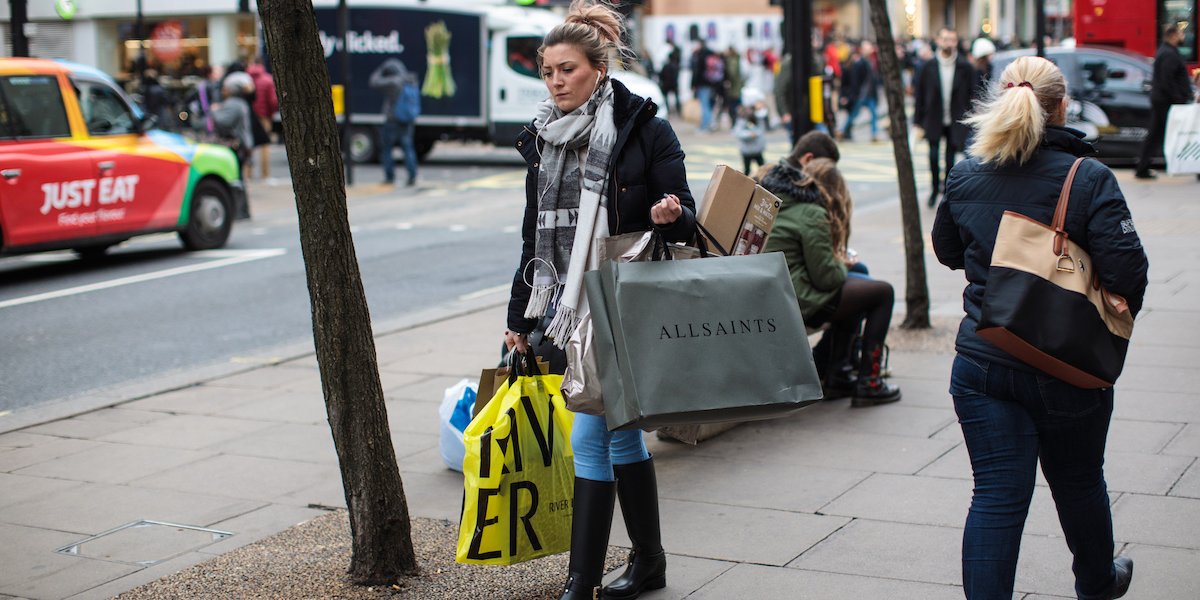 A woman carries shopping bags along Oxford Street in London, on December 24, 2016 in London, England. Christmas shoppers hunt for last minute presents in central London on Christmas Eve.(Photo by Jack Taylor/Getty Images)
A woman carries shopping bags along Oxford Street in London, on December 24, 2016 in London, England. Christmas shoppers hunt for last minute presents in central London on Christmas Eve.(Photo by Jack Taylor/Getty Images)
- Dutch bank ING doesn’t see things getting much better for the squeezed British consumer in 2018.
- Consumers — often described as the powerhouse of the British economy — are struggling in the post-Brexit landscape thanks to high inflation and stagnant wage growth.
- ING economist James Smith compiles three charts that will define the story of British consumers in 2018.
LONDON — British consumers are going to feel a continuing squeeze on their finances, according to analysis from Dutch lender ING.
James Smith, an economist with the bank, compiled three charts that he sees as defining the story of the British consumer in 2018.
First, real wages are not going to rise as fast as many forecasters believe. Smith said ING’s position is “a little more cautious than the Bank of England on wage growth.”
“Policymakers are looking for a sharp pick-up given the ultra-low unemployment rate, which is creating some skill shortages and thus higher pay packets in certain sectors,” he said.
“But with the economy still struggling and other input costs continuing to rise, some firms are likely to take a more cautious approach to pay rises.”
Here’s the chart from Smith and his colleagues:
 ING
ING
While the broader economic picture may be stunting wage growth, there is also another factor in play, namely a shift in the way the British labour market is structured.
For example, those on so-called zero-hours contracts may find it tough to get a pay rise when their boss is not even obliged to even give them any hours of work.
This is exacerbated by the fact that workers in the 21st century are far less likely to be part of a union than in, and as a result do not have the same power to force employers hands as they had during the later half of the 20th century.
There has also been another big, more recent shift, a shift towards the so-called “gig economy,” a class of workers who are technically self-employed and paid per “gig,” typically working in service-style roles like deliveries and taxi-driving, often without set hours and with work assigned via a smartphone app.
Gig economy workers tend to have a much greater deal of flexibility in the way they work, but in turn, sacrifice many of the protections they would receive if they were to have formal employee status.
Next, Smith points to a chart focusing on rising consumer debt in the UK. One of the arguments from the Bank of England around consumer borrowing is that a recent increase “in car loans, and indeed 0% credit card financing, has been led by borrowers with the highest credit scores,” Smith says.
That however, doesn’t tell the whole story, he believes, with Smith say that he suspects “at least some of the rise in unsecured consumer credit has been down to households having to finance some day-to-day spending.”
“If this was the case, we’re likely to see this pattern continue over the next few months given the ongoing income squeeze.”
Here’s the chart:
 ING
ING
Finally, Smith wonders how the British consumer will react to the Bank of England’s rate hike back in November, which saw interest rates increase for the first time in more than a decade — albeit only to 0.5%, a rate seen for almost seven consecutive years between 2009 and 2016.
His conclusion is that the Bank of England’s movements are unlikely “to put a major dent in consumer spending, but could see households become a little more cautious in their financial planning.”
 ING
ING













